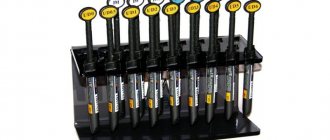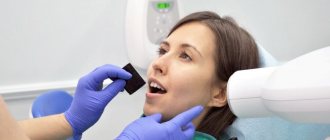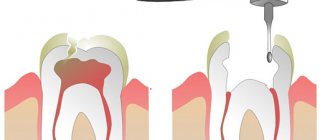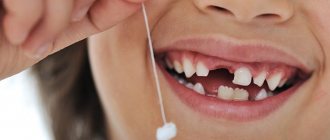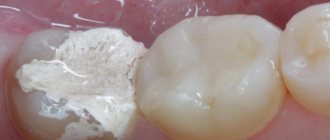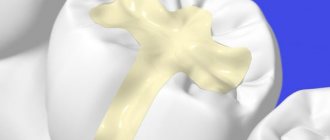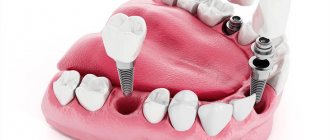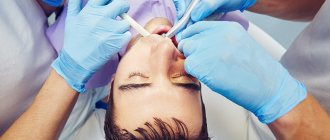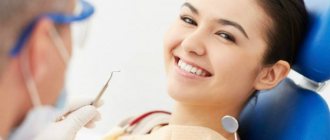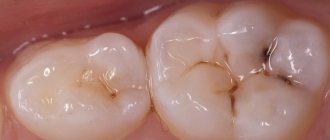- home
- For patients
- Articles
- Dental examination by a dentist
Anyone knows that taking care of your teeth is important. That is why, before treating them, it is necessary to first carry out a diagnosis to identify the cause of the pain. At the One to One dental clinic, the study is carried out in three ways:
- percussion of the tooth crown;
- palpation;
- probing;
These studies are performed as a set of procedures and are similar to each other. The similarity of these methods is that only one tooth is examined at a time, the examination is visual, and this is done by one doctor.
Instrumental visual examination of the oral cavity
When examining the oral cavity, the dentist examines the condition of the cheeks, gums, as well as healthy and diseased teeth. This makes it possible to identify the cause of the pain. This type of research has two stages:
- Visual inspection;
- Probing.
A visual examination of the teeth determines the condition of the tooth enamel. Probing checks the strength of the enamel and the condition of the tooth surface.
Instrumental and visual diagnostics
This type of study is carried out at the One to One clinic in order to be able to identify the extent of tooth decay by caries, and to exclude such types of diseases as hypoplasia and fluorosis, which have nothing to do with caries.
During an examination, any doctor will definitely pay attention to the color of the enamel, or rather to the shades; if it differs from the natural “living” shine, then this indicates that a more thorough study is necessary to identify the diagnosis:
- Gray enamel indicates that pulp removal is necessary.
- Treatment using depophoresis is used for yellow enamel.
- The resorcinol-formaldehyde treatment method is used only for pink enamel.
The purpose of probing is to determine the presence of secondary caries in the teeth on which the filling was placed; it also reveals disease in the grooves on the chewing surfaces, called fissures.
Root tooth fissures
Dental materials, requirements and classification
The main requirements for such materials are: biocompatibility, long-term and reliable connection with the tooth base, good resistance to the environment in the oral cavity, appearance.
Depending on their use, there are five main groups of materials used in dentistry.
- Toothpastes, teeth whitening products, sealants, i.e. everything that serves to prevent dental diseases;
- Restorative materials: filling, adhesive, materials for bases and gaskets;
- Materials used in orthopedic dentistry for treatment after tooth loss (both complete and partial);
- Materials used to treat malocclusion and dentition anomalies. These are materials for braces, metal wire, archwires, etc.;
- Materials from which dental implants are made and used to restore facial tissue;
Depending on the chemical composition, dental materials are divided into ceramic, polymer, metal and their alloys.
Metals perfectly withstand significant mechanical loads and conduct heat well, but the appearance of, for example, dental crowns made from them is not everyone’s cup of tea.
Ceramics and polymers are ideal for reproducing the natural appearance of teeth, and due to their low thermal conductivity, they are also used to protect teeth from sudden changes in temperature.
Often materials with different chemical natures are used in combination with each other, which makes it possible to minimize their undesirable properties and achieve the desired combination.
Probing
To carry out probing and visual examination, the dentist uses an angled probe that has a notch at the end; it must be blunt.
To determine the degree of roughness, the doctor runs an instrument over the surface of the enamel:
A healthy tooth has a smooth surface, but if the tooth is affected by caries, the enamel surface will be rough. The doctor is obliged to check the condition of the periodontal pocket; to do this, he inserts a probe into the gingival groove on four sides of the tooth; if the probe sinks to a depth of 1 mm, then the pocket is healthy. If the immersion is much deeper, this may indicate that the periodontium is atrophied, and this may be caused by pathology.
Atrophied periodontium caused by root caries
Symptoms of the carious process are the following: the size of the gap between the tooth and the filling is increased, the dentitis under the chewing surface is too soft.
During an initial visual examination, it is very difficult to detect tartar deposits on the neck of the tooth, which is located in the periodontal pocket, but this can be detected through probing. The occurrence of periodontitis and gingivitis is provoked by subgingival calculus. The formation of superficial caries can only be recognized by visual inspection.
The influence of the price of instruments on the price of dental services
Let's be honest, many of the patients of dental clinics are frightened at the sight of new and modern dental equipment, believing that dental treatment in such an institution will cost much more.
How does the average private dentistry patient think? The management may try to return the huge amount of money invested in a private dental clinic as soon as possible, so the prices here will be unreasonably high! But in practice, given competition, regulations and rules, many dentists make concessions, trying to find the so-called “golden mean”.
Speaking of Yulistom, management is constantly searching and monitoring promotions for dental equipment and materials.
They are purchased directly from manufacturers, bypassing stores with the appropriate specialization. It is thanks to this that patients of dental clinics near the Zvezdnaya and Pionerskaya metro stations in St. Petersburg are offered affordable prices for healthy teeth! And don’t let modern dental equipment scare you, it in no way affects the fixed prices of dental services (price list at the link). Moscow metro station Zvezdnaya, Danube Avenue, 23
Palpation examination
Using this research method, inflammatory processes are identified, as well as the nature and stage of development of periodontal destruction. To more accurately understand the condition of the tooth, they begin to move it in different directions using tweezers, this makes it possible to understand how it moves in the alveolus:
- In three directions
- In five together with vertical
- In one
- In two.
If a tooth gives in very easily with a little force, this means that there are deviations from the norm, which may be accompanied by tissue swelling and an inflammatory process. These symptoms may indicate the presence of traumatic tooth lesions, such as periodontal disease, periodontitis and periodontitis. It is by palpating the cheeks and gums that the “One to One” doctor receives information about the presence of purulent or bloody discharge, pain, compaction and swelling. A big plus that can be given to the method is that it allows you to instantly obtain the research result upon examination. The only negative that unfortunately exists is the inability to make a definitive diagnosis.
Dental instruments, classification
Dentists' instruments can be classified into the following groups:
- For use in examination and diagnosis;
- Used directly for dental treatment;
- With which the doctor removes deposits from the teeth;
- Instrumentation for dental prosthetics;
- Devices for tooth extraction;
The basic composition of the instruments that the dentist uses during examination: a tray, a dental mirror, various types of tweezers and probes.
Devices used in treatment include polishing and diamond heads, discs, and burs.
When filling and getting rid of softened tissues, the dentist uses an excavator, a plugger and a host of other devices.
There are special instruments for the dentist's actions in root canals.
Auxiliary instruments for treatment are matrices, strips, brushes for lubricating the tooth surface with liquid, etc.
The instruments used to remove deposits from teeth primarily include: curettes, enamel knife, root file, scalers.
There are many types of instruments for dental prosthetics. The main ones are: impression trays, all kinds of spatulas, a micrometer, instruments used to determine the central closure of teeth.
Tools for pulling out teeth include anatomical forceps. Some of them are intended for the upper jaw, others for the lower jaw.
The group described above also includes devices for removing roots; they are called elevators and can be angular, straight or bayonet-shaped.
Instruments used to separate gums before extracting a tooth are also considered instruments used in tooth extraction.
Other instruments of this type include a syringe with anesthetic, various curettes, clamps, and needle holders.
Percussion (tapping)
Percussion with tweezers or a probe handle along the crown of the tooth allows you to determine the location of the area affected by inflammation. Any examination begins with healthy teeth; for this purpose, the edges responsible for cutting and chewing reflexes are tapped on the top and sides of the crown.
The process of tapping teeth (percussion)
A good idea of where the source of inflammation is located is given by the relationship between the nature of the pain and the direction of the blow: periodontitis is detected with a horizontal blow, damage to the root nerve can be determined with a vertical blow. Thanks to this technique, the doctor has the opportunity to identify the place where there is pain and prescribe the necessary treatment.
Orthopedic instruments
This type of dental instruments is represented by metal and plastic spatulas made of different materials, from plastic to metal. They can be flat or curved and are used for processing impression materials and mixing impression materials.
Orthopedic instruments also include impression trays for making plaster models, both perforated and regular, ideally repeating the shape of both rows of teeth and accurately depicting the desired area of the dental system.
Also indispensable in the work of an orthopedist are pliers for plaster and tweezers for soldering, coronal forceps, occlusal retainer, coronal removers and coronal scissors, a micrometer, tweezers for articulating paper and other types of dental instruments necessary for a specialist to professionally perform his duties.
At the same time, the better the quality, and therefore the more convenient and reliable the instruments, the more effective the doctor’s work will be and the safer and more comfortable the patient’s treatment will be.
When should you undergo a general examination by a dentist?
Experienced dentists and orthodontists strongly recommend visiting a dental clinic for a preventive examination at least once every 6 months. This should be done even if there are no complaints. If you have any unpleasant sensations, you should not delay your visit to a medical facility for even a minute.
There are several main causes for concern: increased sensitivity of the enamel, pain in the gums under the denture, swelling, redness and any other visible tissue changes. Also, one of the symptoms of developing pathology is a strong smell from the mouth, which does not disappear even after brushing.
Abundant accumulation of plaque and tartar, changes in the shade and transparency of the enamel, bleeding - all this is a good reason to visit your doctor. Also, consultation and examination are required before orthodontic treatment.
previous post
Why are my teeth numb?
next entry
Surgical instruments
The basic equipment of a surgical room certainly includes:
- Syringes for carpule anesthetics;
- Instruments for peeling gums before removal;
- A variety of forceps for removing teeth and their roots (for the upper and lower jaw, for certain groups of teeth - incisors, premolars, molars), for temporary and permanent teeth; 1,2,4,5,8,10,11,12 - for removal of upper teeth; 3, 6, 7, 9 - for the lower ones;
- Elevators are tools for removing tooth roots. With all the variety of their sizes and shapes, three main types are fundamentally distinguished - straight, angular and bayonet-shaped;
- Scalpels, clamps and needle holders, needles, various holders, etc.
It is extremely difficult to list even the main types of dental instruments. To perform his job efficiently, a modern specialist must have many different devices. And work to improve the quality and range of dental instruments continues continuously...
